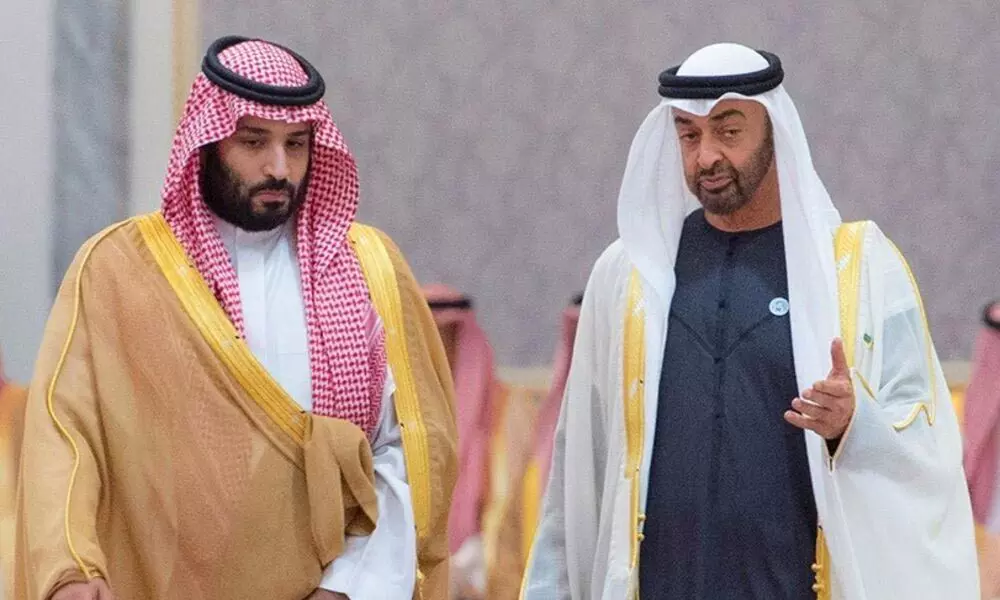Economic reality a testing time for Saudi Arabia, UAE
In the middle of their OPEC dispute, the Saudis announced plans to invest $147 billion in transport and logistics to turn the kingdom into a global aviation hub. That will include creating a new international airline, in addition to the state carrier Saudia. This will not have gone unnoticed in the UAE, which has major aviation hubs in Dubai and Abu Dhabi, and airlines - Emirates and Etihad - to match
image for illustrative purpose

The Middle East's most meaningful alliance has endured territorial disputes, succession crises and the pressures of war in the neighbourhood. Now, the partnership between Saudi Arabia and the United Arab Emirates is being tested by a more existential challenge: economics.
It will survive because the two Gulf Arab countries have many common interests, especially in the spheres of geopolitics and security: They are both threatened by Iran and its proxies, are wary of Turkey's growing influence in the region and fear the political Islam propagated by the Muslim Brotherhood and its offshoots. Their de facto rulers, Saudi Crown Prince Mohammed bin Salman and Abu Dhabi's Crown Prince Mohammed bin Zayed, have a close personal friendship.
But as they chart different economic courses for a post-oil future, the Saudis and Emiratis will find themselves in conflict as often as in a clinch. On occasion, their disagreements will have global consequences. Take their latest ructions over oil-production quotas, which threaten to inflate gasoline prices everywhere. At other times, the ramifications of their economic rivalry will be mostly local, such as Riyadh's self-defeating attempt to lure multinational companies away from Dubai and Abu Dhabi.
But on issues of regional importance, the two sides will find a modus vivendi even when they are not entirely in accord. The Saudis showed no outward sign of anger when the UAE scaled down its involvement in their joint military campaign in Yemen. And the Emiratis made no official protest when the Saudis ended their embargo of Qatar.
Faced with the twin foreign-policy challenges of the rising Iranian menace to the Middle East and the US retrenchment from the region, the rulers of Saudi Arabia and the UAE know they can't let their differences get out of hand. The Iranian threat also has an economic dimension: The Islamic Republic is a major competitor as a producer of oil and natural gas. With a bipartisan consensus developing in Washington for letting the Arab states reach their own accommodation with Tehran, the Emiratis and Saudis need to hang together or be hung out to dry separately.
Still, the two sides have been unusually open in their criticism of each other in their latest spat. At its root, the dispute over production quotas is about national economic priorities. Saudi Arabia and the UAE, the largest and fourth-largest producers in OPEC respectively, are trying to wean their economies off of their dependence on hydrocarbons, but they are at very different stages of that process. Both countries are vulnerable to global trends away from fossil fuels, and worry about a sustained long-term decline in prices.
The Emiratis already have a non-oil economy, having invested for several decades in tourism, transportation and other sectors. They are keen to take the oil revenues while the getting is good, the better to invest in still more diversification. To that end, the UAE is spending billions on oil infrastructure, so it can maximize output as well as revenues.
The Saudis were much slower off the blocks in growing non-oil sectors of their economy, and will need much more time to reduce their dependence on hydrocarbons. Their diversification plans depend heavily on investments by the national sovereign wealth fund, which in turn needs oil prices and revenues to remain steady. Riyadh reckons the best way to achieve this is to leave the oil in the ground for as long as possible.
But both sides will be keenly aware of factors outside their control that could make their dispute moot. The Biden administration seems keen to make a deal with Tehran that would loosen the restraints on Iranian production, leading to a plunge in prices to levels that would upset even the Emiratis. That prospect is an incentive to end the OPEC stalemate.
But the Saudi-Emirati economic rivalry in other areas will continue to intensify. Their diversification plans need foreign investment and talent, both of which are finite commodities. It doesn't help that they are eyeing the same sectors, such as tourism and transportation.
In the middle of their OPEC dispute, the Saudis announced plans to invest $147 billion in transport and logistics to turn the kingdom into a global aviation hub. That will include creating a new international airline, in addition to the state carrier Saudia. This will not have gone unnoticed in the UAE, which has major aviation hubs in Dubai and Abu Dhabi, and airlines - Emirates and Etihad - to match. (Bloomberg)

